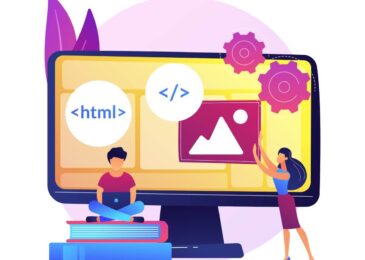Top 5 Things To Consider Throughout Your Web Design Process
Top 5 Things To Consider Throughout Your Web Design Process –
Given the increasing population of individuals getting more active on the World Wide Web, it’s fitting to say that it’s now more important than ever to ensure a strong online presence. Your brick-and-mortar business can’t stand on its own without penetrating the internet. So, to succeed in this task, it is inevitable to work with professional web designers and get the best services of web design in Raleigh NC which try to make every effort to accomplish your requirements in order to increase your sales by providing a great user interface. If you have an e-commerce business, then you should all the more make the effort to ensure your website stands out, functions well, and stays relevant.
Having an efficient and effective website isn’t one you only do at random and expect results to come in overnight. Many factors come into play, so your standard should always be to make it way ahead of your competition and rank in the top landing pages of search engines.
Also Read – How Great Web Design Can Boost Online Sales?
As you go through your web design process, be certain not to miss out on these important things and also check out the top 5 things to consider throughout your web design process as below –
1. Usability –
No matter how well-designed or beautiful your website may be, if it doesn’t pass the usability factor, then it’s still going to be ineffective. It won’t attract website visitors and it’ll only stay stagnant. Strike the perfect balance of a site that works well and looks good.
When it comes to search engine optimization (SEO) standards, usability refers to the process of making your website useful for the average user. Remember that not all of your website visitors are going to be as technologically advanced as you are, so you have to cater to everyone.
Here’s a guide to some of the best metrics to apply in meeting the standard of website usability:
- Optimize your website for mobile devices. As with the rise of smartphones, many internet users are browsing through their mobile devices. If your website design isn’t optimized for handheld gadgets, its interface will change on the screen. You’re going to lose potential website visitors simply because they didn’t have a pleasant experience on your website.
- Keep it easy to navigate through. This means your first-time website visitors should have an easy time finding what they’re looking for by complying with the standards of information architecture. Are you interested to learn more about what information architecture is? One of the many experts laid out their explanation for you to understand.
- Keep your content legible. Apply simple and easy-to-read fonts and colors. Just because a style looks beautiful doesn’t mean you should immediately go for it at the expense of readability. Content is a vital part of your website’s design and function, so be sure it’s legible.
- Choose a clean and consistent layout design. This means incorporating a lot of white space to improve your website’s overall look and function. The space also provides your visitor’s eyes an area to ‘relax’ after going through a lot of elements around your site.
2. Page Loading Speed –
No internet user today has the patience to wait a hundred seconds for a website to load. This may seem like an exaggeration, but this is usually the case. You only have an average of one to three seconds to make the difference when it comes to your page loading speed. Anything beyond that, and you’re going to lose what would’ve been a website visitor. You’re losing precious traffic in favor of another company with a better loading speed.
As you re-design or audit your website, it’s important to consistently test your page loading speed. See to it that there are no bugs or glitches as well.
More so, in compliance with SEO, there are practices that can improve your page loading speed. Here are some guidelines:
- Optimize images, which means your website’s images aren’t larger than they need to be;
- Optimize your content, which means staying within the usual limit of SEO-optimized content length at around 750-2,000 words.
3. Aesthetics –
In this day and age, a stylish website will always stand out. Aesthetics matter, given the stringent competition with many other websites on the internet. Your site’s looks should connect with your brand image since it’s a reflection of who you are as a business and how you can visually communicate with your audience. Also, it should be appealing enough such that people would be attracted to look at your site and stay there for longer.
The challenge with aesthetics is that the website design industry is moving at a fast pace, and if you aren’t careful, you may still be using outdated techniques. Being in this scenario can stagnate your platform. To help you overcome this challenge, here are insightful tips on how you can stay on top by ensuring your website’s aesthetics is the best:
- Keep your design colors consistent with your logo, brand name, and the niche your business belongs to (e.g. if you’re an e-commerce website selling children’s goods, keep the colors bright as you’d see in a kindergarten);
- Simplify your headers, tabs, and your navigation tabs;
- Use graphics and videos.
4. Content –
Your content always forms a huge part of your website design process simply because a bulk of your site contains it. Your website has to be tailored hand-in-hand with your content, so the two can match accordingly. Otherwise, even if you have a well-designed website, you’re not going to have any website visitors. Also, what you post should always be timely and significant. After all, your online platform is nothing without the content in it.
Here’s a good checklist you can follow to lay down the framework for your website’s content:
- Do keyword research. This is crucial to ensure your website’s content ranks high in search engine results through meeting the keywords used by your target market. Your goal should be to make your site land the top results after an internet user makes a search. This can be achieved through good website design accompanied by relevant and up-to-date content, as evidenced by stuffing in the right keywords. These keywords are what the search engine’s crawlers will skim through to decide whether or not your website is the answer to the user’s query or search.
- Always produce quality and edited content. This means never publish any content haphazardly. Even if you have a dedicated team of writers or you’re a seasoned writer yourself, there’s nothing better than submitting your drafts for editing before publishing. Editors have the expertise needed to ensure an article is of premium quality in terms of grammar, spelling, style, and relevance.
- Employ a relatable tone. This means your readers should immediately have a grasp of what you’re talking about. As much as you can, avoid highly technical terms as this may not be easily understood by everyone. Think of your tone like you’re simply talking to a friend. The simpler it is, the better.
5. Enable Chatbot Support –
Chatbots are the modern-day rising stars across websites and social media messaging platforms. These are robots in place of human customer service representatives with whom your website visitors can ‘talk to’ should they have any concerns. Chatbots are programmed to provide answers to a query made on your live chat system. If there’s anything too complicated for the chatbot to address, these are forwarded on the same day to an agent from your team, or the next working day if the message was made past office hours.
Enabling chatbot support is one of the earmarks of improved customer service for e-commerce websites. It’s just fitting to enable one as you design your website. While chatbots aren’t perfect and can never be a replacement for human customer service support, there’s no better time than now to install one for your site, especially that many more shoppers are opting to buy online rather than purchase through a brick-and-mortar store.
As you devise a strategy to incorporate chatbots in your website design, be sure to understand the benefits of having one:
- It increases your website’s availability. Your online presence is 24/7. At any given time when customers have a concern, this can be addressed without making them wait too long for a representative to be free, elevating your site’s customer service;
- It’s multi-lingual. This means it can cater to a global range of customers, particularly if you’re running an e-commerce website that ships internationally.
As a rule of thumb, seek professional advice when it comes to coming up with a functional website, so you’d rest assured the output would be excellent. Having an online platform can be quite complex if you’re going to do it yourself. Also, see to it that you’re definite with what you’re about to do since anything you publish online can be made available to all users. Always think before you click.
Conclusion –
As you can see, there are many factors coming into play when you’re designing a website. More so now that the competition is getting fierce, it’s all the more necessary to ensure your online platform is designed for success. If not, your site is simply going to fall behind the competition.
Whether you’re coming up with a new website design or you’re simply re-designing, these factors are all effective in achieving your business’s goals. Take this as your checklist, so you can ensure you go through every item without forgetting anything. Consider the ideas mentioned here as you come up with a blueprint for your web design.
Author Bio –
Ivy Luna is an SEO guru for more than eight years. As she works with an SEO company, she also specializes in the website design process while factoring in the different metrics set forth by SEO. When she’s not immersing herself in the codes of websites, she loves to go camping with her four-legged best friend, Light.
Also Read – How To Hire Freelance Web Developers Who Get The Job Done?





